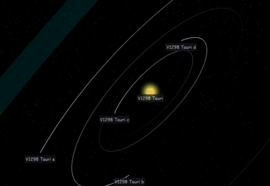 The planetary system V1298 Tauri Credit: Exoplanet Exploration Program and the Jet Propulsion Laboratory for NASA’s Astrophysics Division | |
| Observation data Epoch J2000.0 Equinox J2000.0 | |
|---|---|
| Constellation | Taurus |
| Right ascension | 04h 05m 19.59121s[1] |
| Declination | +20° 09′ 25.5635″[1] |
| Apparent magnitude (V) | 10.31 - 10.43[2] |
| Characteristics | |
| Spectral type | K0-K1.5[3] |
| Variable type | Irregular[2] |
| Astrometry | |
| Proper motion (μ) | RA: 5.228 ± 0.131[1] mas/yr Dec.: -16.077 ± 0.048[1] mas/yr |
| Parallax (π) | 9.2139 ± 0.0593 mas[1] |
| Distance | 354 ± 2 ly (108.5 ± 0.7 pc) |
| Details | |
| Mass | 1.095+0.049 −0.047[4] M☉ |
| Radius | 1.33+0.04 −0.03[4] R☉ |
| Luminosity | 0.934 ± 0.044[3] L☉ |
| Temperature | 4970 ± 120[3] K |
| Rotation | 2.97+0.03 −0.04 d[4] |
| Age | 23 ± 4[3] Myr |
| Other designations | |
| Database references | |
| SIMBAD | data |
V1298 Tauri is a young (23±4 Myr) weakly-lined T Tauri star[5] that is part of the Taurus-Auriga association in the Taurus Molecular Cloud. Alternatively it is part of a proposed moving group, called Group 29 that is slightly older.[6][7][3] The system has four transiting exoplanets, discovered with the Kepler space telescope in the K2 mission.[5] One of the planets was discovered in August 2019[3] and the other three were discovered in November 2019 by the same team.[5]
- ^ a b c d e Gaia Collaboration (2018-08-01). "Gaia Data Release 2 - Summary of the contents and survey properties". Astronomy & Astrophysics. 616: A1. arXiv:1804.09365. Bibcode:2018A&A...616A...1G. doi:10.1051/0004-6361/201833051. ISSN 0004-6361. S2CID 49211658.
- ^ a b Samus, N. N.; Durlevich, O. V.; et al. (2009). "VizieR Online Data Catalog: General Catalogue of Variable Stars (Samus+ 2007-2013)". VizieR On-line Data Catalog: B/GCVS. Originally Published in: 2009yCat....102025S. 1: B/gcvs. Bibcode:2009yCat....102025S.
- ^ a b c d e f David, Trevor J.; Cody, Ann Marie; Hedges, Christina L.; Mamajek, Eric E.; Hillenbrand, Lynne A.; Ciardi, David R.; Beichman, Charles A.; Petigura, Erik A.; Fulton, Benjamin J.; Isaacson, Howard T.; Howard, Andrew W. (August 2019). "A Warm Jupiter-sized Planet Transiting the Pre-main-sequence Star V1298 Tau". The Astronomical Journal. 158 (2): 79. arXiv:1902.09670. Bibcode:2019AJ....158...79D. doi:10.3847/1538-3881/ab290f. ISSN 0004-6256. S2CID 119003936.
- ^ a b c Feinstein, Adina D.; David, Trevor J.; Montet, Benjamin T.; Foreman-Mackey, Daniel; Livingston, John H.; Mann, Andrew W. (2022). "V1298 Tau with TESS: Updated Ephemerides, Radii, and Period Constraints from a Second Transit of V1298 Tau E". The Astrophysical Journal Letters. 925 (1): L2. arXiv:2111.08660. Bibcode:2022ApJ...925L...2F. doi:10.3847/2041-8213/ac4745. S2CID 244130016.
- ^ a b c Cite error: The named reference
David et al 2was invoked but never defined (see the help page). - ^ Oh, Semyeong; Price-Whelan, Adrian M.; Hogg, David W.; Morton, Timothy D.; Spergel, David N. (June 2017). "Comoving Stars in Gaia DR1: An Abundance of Very Wide Separation Comoving Pairs". The Astronomical Journal. 153 (6): 257. arXiv:1612.02440. Bibcode:2017AJ....153..257O. doi:10.3847/1538-3881/aa6ffd. ISSN 0004-6256. S2CID 119351439.
- ^ Luhman, K. L. (December 2018). "The Stellar Membership of the Taurus Star-forming Region". The Astronomical Journal. 156 (6): 271. arXiv:1811.01359. Bibcode:2018AJ....156..271L. doi:10.3847/1538-3881/aae831. ISSN 0004-6256. S2CID 119471553.
© MMXXIII Rich X Search. We shall prevail. All rights reserved. Rich X Search
